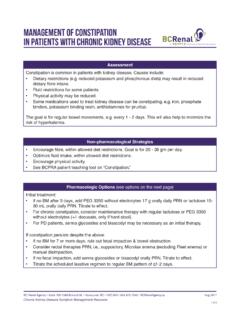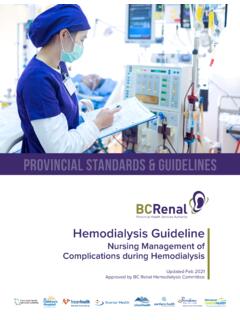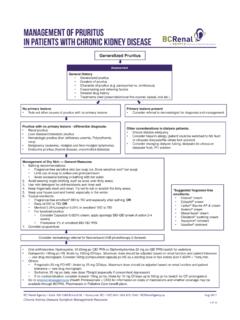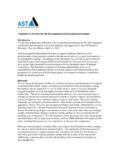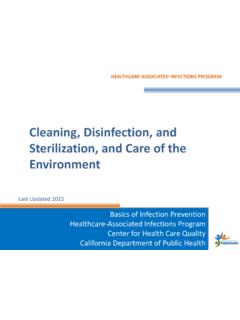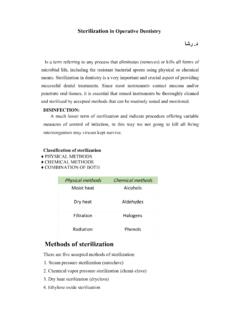Transcription of Cleaning & Disinfecting Hemodialysis Machines & Stations
1 Cleaning & Disinfecting Hemodialysis Machines & StationsRevised July 2019 Approved by the BC Hemodialysis Committeethe northern way of caringBC Renal July 2019BC RenalPhone: 604-875-7340 Email: of Scope of Guideline .. Definitions .. Recommendations .. References .. Sponsors .. Appendices ..7 Appendix 1: Checklist for Dialysis Station Routine Disinfection ..8 Appendix 2: Checklist for Disinfecting Small Multi-Use Items ..10 Appendix 3: National/International Standards (for background) ..11 IMPORTANT INFORMATIONThis BC Renal guideline/resource was developed to support equitable, best practice care for patients with chronic kidney disease living in BC.
2 The guideline/resource promotes standardized practices and is intended to assist renal programs in providing care that is reflected in quality patient outcome measurements. Based on the best information available at the time of publication, this guideline/resource relies on evidence and avoids opinion-based statements where possible; refer to for the most recent version. For information about the use and referencing of BC Renal guidelines/resources, refer to !BC Renal July Scope of Guideline This guideline provides a standardized procedure for Cleaning and Disinfecting Hemodialysis (HD):(a) Machines ; and (b) Stations (routine Cleaning & disinfection only).
3 The guideline applies to the provision of Hemodialysis (HD) and hemodialfiltration (HDF) in: In-centre HD units (both adult and pediatric units). Community dialysis units (CDUs). DefinitionsRinse: Flushing the internal hydraulics of the dialysis machine with water that meets CSA dialysis :Removal of calcification / precipitate from within the internal hydraulics of the dialysis machine. , citric acid or acetic acid-based product or removal of Disinfection: Destruction of pathogenic and other kinds of microorganisms by thermal means. NOTE: Disinfection is a less lethal process than sterilization. It destroys most recognized pathogenic microorganisms but does not necessarily destroy all microbial Disinfection:Destruction of pathogenic and other kinds of microorganisms by chemical means.
4 Chemicals can include: sodium hypochlorite (bleach), sodium carbonate, peracetic acid / hydrogen peroxide blend ( , Minncare, Dialox). Descalent with Heat Disinfection: Combination of descalent and heat disinfection. Machine Types: Artis = Baxter Gambro ArtisPhoenix = Baxter Gambro PhoenixFresenius = Fresenius 5008 RecommendationsRecommendation #1: Each HD unit develops a process to identify, update and document the frequency of machine disinfection required for a specific patient based on the frequency tables in recommendation #2. Suggested mechanisms to identify the frequency of machine disinfection include:* Nephrologist/Nurse Practitioner writes an order in the patient record; or* Nephrologist/Nurse Practitioner provides education to the HD RNs/renal techs.
5 HD RNs/renal techs identify the location for documentation of Hepatitis B status and frequency of disinfection: HD log ( run sheet). Recommendation #2: Disinfect internal pathways, the external surface of the HD machine and peripheral equipment and accessories as per Tables 1, 2 and 3. Standards on Tables 1, 2 and 3 are consistent with the Canadian Standards Association (CSA) standards with one exception noted in the footnote. BC Renal July 20192 Table 1: Disinfection of Hemodialysis /HDF Machines & Peripheral Equipment & Accessories1 Recomm-endationInternal Pathways2 Blood Tubing Transducer ProtectorsExternal Sur-face of HD MachinePeripheral Equipment & AccessoriesHD, no on-line priming or substitution fluidHD with on-line priming or HDF sub-stitution fluidHep B: Refer to Table 2 Hep B status unknownDisinfect after each patient (even if two consecutive runs of Hep B+ patients).
6 Disinfect after each using on-line priming or using machine for HDF, machine must be disinfected before each use ( , if machine used on previous patient for conventional HD, machine must be disinfected before using on-line priming or using for HDF). If not possible, do not use on-line priming ( , use saline) or for HDF. If blood tubing transducer protector(s) comes in contact with a patient s blood, remove HD machine from clinical care after treatment is completed for biomedical inspection & disinfect machine after each patient & before machine is moved from a patient area to another to recommendation #2 for a description of routine disinfection of the dialysis station.
7 If single-use, discard. If can t discard, dedicate to single patient where possible ( , tape, tourniquet).Disinfect peripheral equipment used with HD machine ( , wands, BP cuff) after each other patientsDisinfect at end of day3; ANDD isinfect after patient if blood leak occurs outside the blood pathway ( , membrane is compromised & blood enters the dialysate pathway).If blood was confirmed in the dialysate effluent, change the dialyzer, complete the run with the same patient, perform a heat or bleach disinfection, and pull the machine for Biomedical Engineering to per above. If not using on-line priming or using for HDF, disinfect as per instructions in column to the left ( HD, no on-line priming or substitution fluid ).
8 As per per per The type of disinfection selected (heat, chemical or heat/descalent combination) will depend on the type of machine and the manu-facturer s recommendations for Refer to Table 3 for specifics. 3 CSA Standards (CSA , 2013) states the internal path of the HD machine shall be disinfected between each patient use. The rationale deviating from this is: Disinfecting at the end of the day (vs after each patient) is standard practice for conventional HD in BC and across Canada. There is no known evidence to suggest an increased risk of infection as a result of not Disinfecting between every patient. It may not be feasible in some units to disinfect after every patient (lengthens the time between treatments and could mean fewer treatments per day).
9 BC Renal July 20193 Table 2: Hepatitis B Status & Disinfection of Hemodialysis /HDF Machines Hepatitis B StatusDisinfection RecommendationHBsAgNegativeSusceptibleRo utine (as per all other patients on Table 1)Anti-HBcNegativeAnti-HBsNegativeHBsAgN egativeImmune due to natural infectionRoutine (as per all other patients on Table 1)Anti-HBcPositiveAnti-HBsPositiveHBsAgN egativeImmune due to hepatitis B vaccinationRoutine (as per all other patients on Table 1)Anti-HBcNegativeAnti-HBsPositiveHBsAgP ositiveAcutely infectedDisinfect after each patientAnti-HBcPositiveIgM anti-HBcPositiveAnti-HBsNegativeHBsAgPos itiveChronically infectedDisinfect after each patientAnti-HBcPositiveIgM anti-HBcNegativeAnti-HBsNegativeHBsAgNeg ativeInterpretation unclear: 4 possibilities:1.
10 Resolved infection (most common)2. False-positive-anti-HBc, thus susceptible3. Low level chronic infection4. Resolving acute infectionDisinfect after each patient if: HBV status unknown Confirmed HBV+; and Anti-HBS <10 IU/LAnti-HBcPositiveAnti-HBsNegativeSour ce: Columns under Hepatitis B status : Centers for Disease Control and Prevention (CDC). Renal July 20194 Table 3: Specifics re: Disinfection of the Internal PathwaysItemRecommendationMax time between disinfection and use24 hoursMax storage time between disinfections, regardless of use48 hoursUnless contraindicated by the machine manufacturer, place a low grade disinfectant into the machine if it is expected to sit for more than 48 hours.

